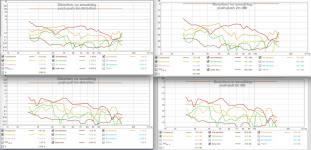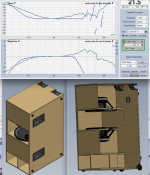I liked your Keystone tapped horn running dual 12's
You say it puts out 6dB more than a ported sub provides? I figured it would be a little higher but every little bit helps.
By the time I figure out tapped horns, horn response, keystone mouths and have it all designed--they will probably obsolete the drivers.
First the single 10", I can screw around with it and really like the keystone mouth. +6dB boost from the alignment will give me 94dB... close enough for garage duty.
You say it puts out 6dB more than a ported sub provides? I figured it would be a little higher but every little bit helps.
By the time I figure out tapped horns, horn response, keystone mouths and have it all designed--they will probably obsolete the drivers.
First the single 10", I can screw around with it and really like the keystone mouth. +6dB boost from the alignment will give me 94dB... close enough for garage duty.
The dual Lab 12 Keystone was about 7 dB more sensitive than the dual 12 half the size.I liked your Keystone tapped horn running dual 12's
You say it puts out 6dB more than a ported sub provides? I figured it would be a little higher but every little bit helps.
http://www.diyaudio.com/forums/subwoofers/185588-keystone-sub-using-18-15-12-inch-speakers-2.html
Post #1 has the chart comparing it, post #12 goes over the distortion, which is about the same as the ported cabinet on average.
It would be fairly easy to make a "donut" adapter that would allow the dual 12 Keystone to be run in PP, if it didn't work as well as normal, it could be switched back.
I wish I would have done that experiment, but the BC18115-4 sounded better than the Lab 12s, and could take way more power and still sound clean, so I was not inclined to pursue it too much.
I've had some good luck with push pull speakers.
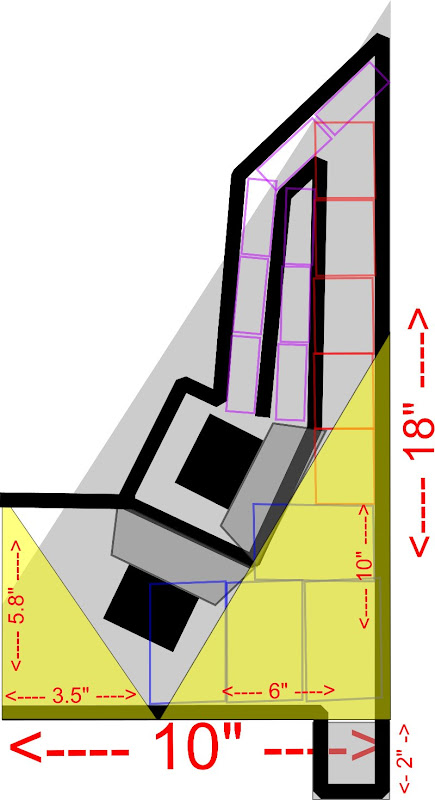
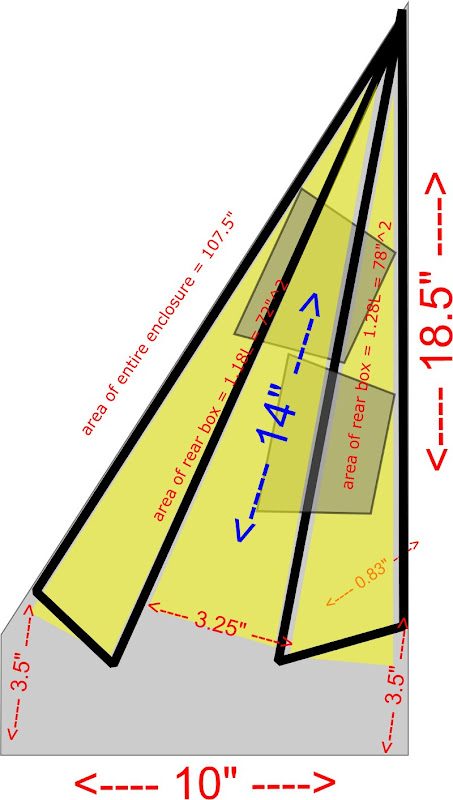
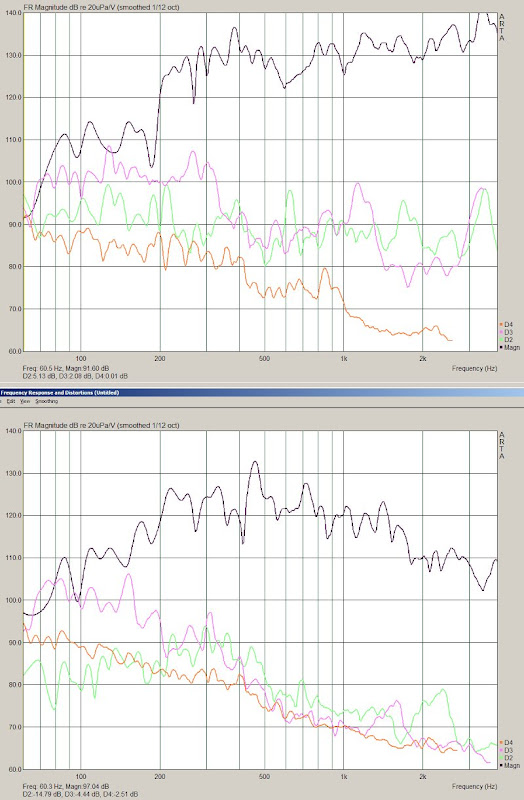
The pictures and graph above are from a push-pull project I did. One enclosure is a front-loaded horn, one enclosure is a tapped horn. We see the following:
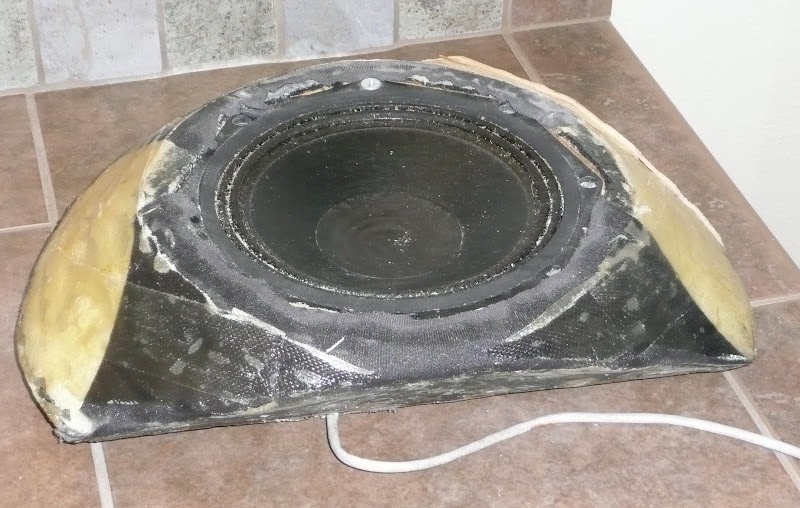
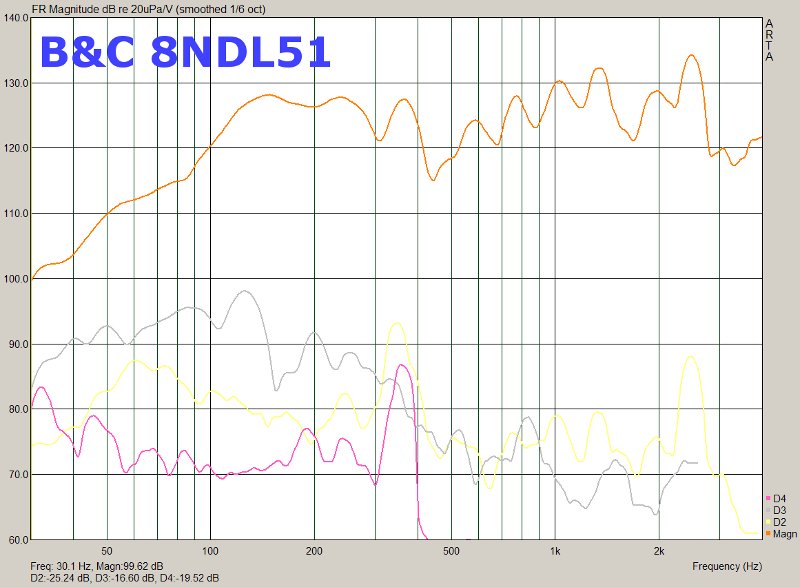
Here's a B&C 8NDL51 for comparison's sake. I'd say the push-pull Auras do pretty well, particularly since they're under $80 a pair.



The pictures and graph above are from a push-pull project I did. One enclosure is a front-loaded horn, one enclosure is a tapped horn. We see the following:
- The low-pass effect of a front loaded horn is really nuking distortion at high frequencies
- push-pull seems to be making a noticeable reduction in distortion (look at 2nd versus 3rd in the range of 100 to 400hz)
- If you look at the entire bandwidth range, the tapped horn has more output at the expense of higher distortion. Note that in the real world we would likely use a larger driver with the TH than with the FLH, which would reduce distortion


Here's a B&C 8NDL51 for comparison's sake. I'd say the push-pull Auras do pretty well, particularly since they're under $80 a pair.
Yes, even order harmonic distortion is largely eliminated, leaving the more objectionable odd order left when driven hard.Random thought. I always considered Isobaric to be a cheat for a too small motor, but would you get the same advantage in distortion with cone-to-cone facing Isobaric?
I used a pair of $5 Sammi 10" in a cone-to-cone facing isobaric tqwp:
http://www.diyaudio.com/forums/subwoofers/206955-10-plus-wood-18hz-isot-tqwp-sub.html
Art Welter
Yes, even order harmonic distortion is largely eliminated, leaving the more objectionable odd order left when driven hard.
Seems like a good match for an acoustic bandpass alignment - the isobaric loading will take care of the even order frequencies and the acoustic bandpass could reduce the audibility of the odd-order ones above the system's passband.
Since comparative push-pull and push-push distortion measurements are hard to locate, thought it would be good to reference Mark100's work here too:
A Thread for those interested in PPSL enclosures
post #758 Mark wrote:
"Since the whole idea of push-pull is 2nd order harmonic distortion reduction,
I decided to test push-pull inverted, vs push-push (clamshell) using the same box.
First plot is push-pull.
Second is push-push.
Both were at 2 meters, so add 6dB to SPL.
I don't see enough of a clear case for push-pull.................??
Plus, the suspension and coil vent noise below 35Hz, was much louder with the pull driver when exposed in the plenum, than when the driver rests in the cabinet as a push driver like its brother.
So, I'm going with push-push.
This gives the vibration reduction (which is dramatic vs a regular dual 18), and allows for a very easy rotation of drivers to get over the horizontal sag stuff.
Last plot is a transfer for the push-push. Dark green is raw, blue is processed.
My SPL Leq method of finding sensitivity gives 101.3 dB 2.83v at 1m, with the processing in place.
THD hit 10% right at 130dB 1m.
Happy camper!!"
His direct comparison using a pair of BMS 18N862 indicates how little distortion changes between push-pull and push-push when using (very) clean high excursion drivers below Xmax.
The 2nd and 3d harmonic distortion levels at around 126dB one meter (120dB 2meters) are under 2% for the push-push (slightly more for push-pull) but rise to 10% when pushed to 130dB, likely reaching Xmax at that level.
Art
A Thread for those interested in PPSL enclosures
post #758 Mark wrote:
"Since the whole idea of push-pull is 2nd order harmonic distortion reduction,
I decided to test push-pull inverted, vs push-push (clamshell) using the same box.
First plot is push-pull.
Second is push-push.
Both were at 2 meters, so add 6dB to SPL.
I don't see enough of a clear case for push-pull.................??
Plus, the suspension and coil vent noise below 35Hz, was much louder with the pull driver when exposed in the plenum, than when the driver rests in the cabinet as a push driver like its brother.
So, I'm going with push-push.
This gives the vibration reduction (which is dramatic vs a regular dual 18), and allows for a very easy rotation of drivers to get over the horizontal sag stuff.
Last plot is a transfer for the push-push. Dark green is raw, blue is processed.
My SPL Leq method of finding sensitivity gives 101.3 dB 2.83v at 1m, with the processing in place.
THD hit 10% right at 130dB 1m.
Happy camper!!"
His direct comparison using a pair of BMS 18N862 indicates how little distortion changes between push-pull and push-push when using (very) clean high excursion drivers below Xmax.
The 2nd and 3d harmonic distortion levels at around 126dB one meter (120dB 2meters) are under 2% for the push-push (slightly more for push-pull) but rise to 10% when pushed to 130dB, likely reaching Xmax at that level.
Art
Attachments
Vibration reduction-a light cabinet won't walk around the floor with the moving driver weight cancelled.
The plenum also increases headroom in the upper bass range, more "punch" available.
The plenum reduces internal volume, the trade-off between reduced lower and increased upper output is a consideration that may favor opposing side mounting for most home use.
Art
The plenum also increases headroom in the upper bass range, more "punch" available.
The plenum reduces internal volume, the trade-off between reduced lower and increased upper output is a consideration that may favor opposing side mounting for most home use.
Art
Last edited:
Hi Art, brings back some good memories, thx ! 
Brian, imo the vibration reduction Art lists is a massive, hard to overstate benefit.
I really believe it is worth more than 90% of all the bracing we put into our typical sub builds, in terms of sonic improvement.
I think it also means energy is going into sound instead of the cabinet wanting to vibrate or start walking.
It's so nice to not see, feel, or hear, a sub cabinet vibrating.
FLH Labhorns are the same way with opposed 12" drivers inside them...the subs plain sit still as they shake the hell out of everything around them.
For home, even if just sealed, I'll never make another sub that isn't dual opposed. (unless maybe quad opposed)
I'm thinking about a Hyperion-like vented, with side mounted drivers simply firing outward, that vent towards the floor.
Brian, imo the vibration reduction Art lists is a massive, hard to overstate benefit.
I really believe it is worth more than 90% of all the bracing we put into our typical sub builds, in terms of sonic improvement.
I think it also means energy is going into sound instead of the cabinet wanting to vibrate or start walking.
It's so nice to not see, feel, or hear, a sub cabinet vibrating.
FLH Labhorns are the same way with opposed 12" drivers inside them...the subs plain sit still as they shake the hell out of everything around them.
For home, even if just sealed, I'll never make another sub that isn't dual opposed. (unless maybe quad opposed)
I'm thinking about a Hyperion-like vented, with side mounted drivers simply firing outward, that vent towards the floor.
Last edited:
Probably pretty good on reducing that "floor coupling" if in a house or up on a stage...It's so nice to not see, feel, or hear, a sub cabinet vibrating.
Yep, probably helps with that.Probably pretty good on reducing that "floor coupling" if in a house or up on a stage...
Although, with no vibration coming from the push-push sub cabinet, I still gets tons of floor vibration just from the air-borne bass waves.
I like it really, part of the tactile aspect of good bass, imo.
- Home
- Loudspeakers
- Subwoofers
- Push Pull vs Normal Distortion Compared
